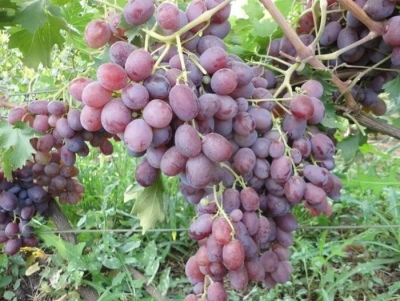
- Authors: Krainov Viktor Nikolaevich
- Berry color: dark red, burgundy chocolate
- Taste: harmonious
- Ripening period: early
- Ripening period, days: 115
- Frost resistance, ° C: -23
- Bunch weight, g: 700-1800
- Flower type: bisexual
- Density of the bunch: medium density
- Berry shape: oval, ovoid
The Abu Hassan grape is a promising and fruitful variety, beloved by both novice and experienced farmers.
Breeding history
The variety appeared thanks to the famous breeder Viktor Nikolaevich Krainov.
Geography of distribution
The crop can be planted in many regions of the Russian Federation. Grapes grow well in the climatic conditions of the Moscow region.
Description
To understand whether it is worth purchasing an Abu Hasan seedling and planting it on your site, it is important to find out the main characteristics of the variety.
Ripening period
The bush has an early ripening period. The fruit can be harvested after 115 days.
Bunches
Beautiful conical clusters are not too dense, as the berries are not closely adjacent to each other. Weight varies from 700 to 1800 g. They have a high level of transportation.
Berries
Ripe fruits of a dark red, burgundy-chocolate color have a dense and crunchy flesh. The berries are oval and ovoid, neat, weighing about 15-20 g on average.
Taste
The taste of berries is harmonious.
Yield
The bushes are high-yielding, the vine ripens very well.


Growing features
When grown correctly, gardeners can produce a robust, healthy plant that produces bountiful, quality crops.
Landing
A sunny place is chosen for planting a plant. If this is not the case, you can plant a culture in partial shade. The soil should be fertile and well-drained.

Pollination
The bisexual flowers allow the cultivar to pollinate on its own.
Pruning
There are several main rules for performing pruning:
it is better to do pruning on sunny days;
tools must be kept clean and sharpened;
it is necessary to cut in the middle of the internode so that the upper kidney "looks" up;
it is important to make sure that the cut will be in the correct area.

Watering
An adult bush is watered several times:
in late spring, before the buds bloom;
7 days before the flowering period;
after the flowering period;
late autumn.
It is extremely important to carry out watering for young seedlings of the culture, as this allows them to take root well on the site and develop correctly.


Top dressing
Fertilizers are first laid in the hole during planting, after feeding, they are carried out in conjunction with watering. This should be done from 3 years of growth of the bush, when it begins to bear fruit. Early spring soil filling is an important step in grape care. Organic fertilizers are used for it, which will quickly be absorbed. This can be bird droppings or slurry.
Organics should ferment for about a week. Fertilizer is prepared according to the following principle: a bucket of manure for several buckets of water. Before adding the product, you need to dilute it with liquid 1 to 10. Several buckets of top dressing are introduced into the holes located along the radius of the bushes. 10 days before the beginning of the flowering period, you need to feed the plant with mineral fertilizers (13 g of potassium salt, 20 g of ammonium nitrate and 30 g of superphosphate per 10 liters of water). One bush takes several buckets of fertilizer.
When the fruits are the size of peas, mineral fertilizers should be applied again (one bucket per bush). Young plants should not be fertilized with nitrogen-rich groundbaits too much, as this may lead to a deterioration in the maturation of the shoots. Fertilizers with potassium and phosphorus are applied along with irrigation.
Frost resistance and the need for shelter
The Abu Hasan variety can withstand low temperatures down to -23 degrees.

Diseases and pests
It is a highly disease resistant variety. The grapes of Abu Hasan are not afraid of mildew, oidium and gray rot. Despite this, it is recommended to carry out preventive measures.

If a grape is exposed to any disease or insect, this always affects its appearance.
Storage
The bunches are well kept in conditions acceptable for this.











































































